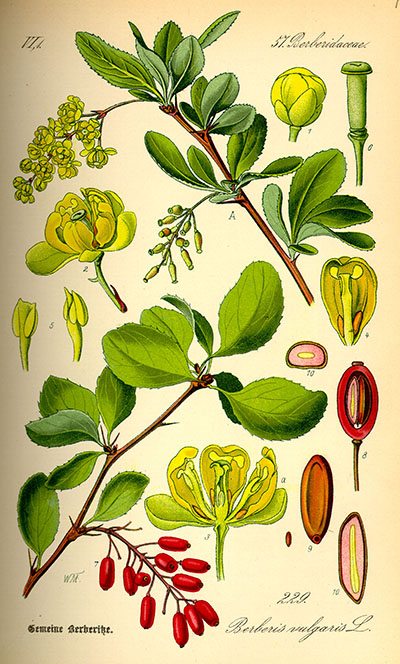Common Barberry
- Description of Common Barberry
- Distribution and Ecology of Common Barberry
- Raw Materials from Common Barberry
- Chemical Composition of Common Barberry
- Uses and Benefits of Common Barberry
- Precautions for Using Common Barberry
- Contraindications for Using Common Barberry
- Medicinal Recipes with Common Barberry
- Cosmetic Uses of Common Barberry
- Culinary Uses of Common Barberry
Common Barberry
Berberis vulgaris L.
Berberidaceae Family
Description of Common Barberry
Common Barberry is a thorny shrub, 3.3–9.8 ft (1–3 m) tall, with gray-brown bark and branches covered with triple spines (up to 0.8 in or 2 cm). Leaves are alternate, elliptical, 0.8–2 in (2–5 cm), finely toothed, green, turning red in autumn. Flowers are yellow, 0.24–0.35 in (6–9 mm), gathered in drooping racemes (1.2–2.4 in or 3–6 cm). Fruits are oblong berries, 0.31–0.47 in (8–12 mm), bright red or purple, sour, with 1–3 seeds. Cultivars: ‘Atropurpurea’, ‘Aurea’, ‘Marginata’. Flowering occurs in May–June, fruiting in August–September.
Distribution and Ecology of Common Barberry
Common Barberry originates from Europe, the Caucasus, and Asia Minor. It grows in the forest-steppe zones of Russia, Ukraine, Belarus, Central Asia, and Crimea, up to 6,562 ft (2,000 m) above sea level. It is cultivated in gardens in Europe, Asia, and North America. It prefers light, well-drained soils (pH 6.0–7.5), sunny locations, and irrigation of 2.6–4 gal (10–15 L) per bush every 10 days. Propagated by cuttings, seeds, or layering. Yield: 11–22 lb (5–10 kg) per bush. Care includes pruning, nitrogen fertilization (0.35–0.53 oz/m² or 10–15 g/m²), and protection from aphids and rust. Used in landscaping, as a honey plant, and for slope stabilization.
Raw Materials from Common Barberry
Raw materials include fruits (fructus Berberidis), root bark (cortex radicis Berberidis), and leaves (folia Berberidis). Fruits are harvested in August–September, dried at 104–122°F (40–50°C), yielding 15–20%. Root bark is collected in spring or autumn, dried at 122°F (50°C), yielding 10–15%. Leaves are collected in June–July, dried at 104°F (40°C), yielding 20–25%. Quality standards: fruits red, mold-free; bark yellowish-brown; leaves green; moisture <12%. Store in airtight containers (fruits: 1 year; bark: 3 years; leaves: 1 year). Aroma is faint, taste is sour.
Chemical Composition of Common Barberry
Fruits contain sugars (up to 7%), organic acids (malic, citric, up to 6%), pectins (up to 1%), vitamin C (up to 80 mg/100 g), K, E, flavonoids, anthocyanins, minerals (K, Ca, Fe). Root bark contains alkaloids (berberine up to 9%), tannins (up to 2%). Leaves contain vitamin C (up to 100 mg/100 g), berberine, flavonoids. Fruit calories: 30–35 kcal/100 g.
Uses and Benefits of Common Barberry
Common Barberry has choleretic, anti-inflammatory, antimicrobial, antispasmodic, hypotensive, and hemostatic effects. It is used for hepatitis, cholecystitis, diarrhea, hypertension, uterine bleeding, throat inflammations, and skin conditions (eczema, psoriasis). Fruits improve appetite and strengthen immunity. Root bark (berberine) is used for liver and bile duct disorders. Leaves are used for colds and stomatitis. Juice lowers cholesterol and normalizes blood pressure. Consult a healthcare professional before medicinal use.
Precautions for Using Common Barberry
Consuming >17.6 oz (500 g) of fruits or >3.4 oz (100 ml) of juice daily may cause nausea or diarrhea. Root bark preparations (>0.18 oz or 5 g daily) are toxic due to berberine (causing dizziness, low blood pressure). Store juice at 32–41°F (0–5°C) for no longer than 24 hours. For children under 5, limit fruits to <1.06 oz (30 g) daily. Avoid unripe berries (toxic). Wash fruits thoroughly to remove pesticides.
Contraindications for Using Common Barberry
Common Barberry is contraindicated for allergies to Berberidaceae, liver cirrhosis, gallstone disease, hypotension, pregnancy, lactation, and children under 2 years.
Medicinal Recipes with Common Barberry
- Root bark infusion for cholecystitis. Steep 0.18 oz (5 g) bark in 6.8 oz (200 ml) boiling water for 30 minutes, drink 1.7 oz (50 ml) twice daily for 7 days.
- Fruit decoction for diarrhea. Boil 0.7 oz (20 g) dried fruits in 6.8 oz (200 ml) water for 15 minutes, drink 1.7 oz (50 ml) three times daily for 5 days.
- Juice for hypertension. Drink 1.7 oz (50 ml) juice twice daily for 10 days.
- Leaf compress for eczema. Steep 0.35 oz (10 g) leaves in 3.4 oz (100 ml) boiling water for 20 minutes, apply for 15 minutes twice daily for 5 days.
Cosmetic Uses of Common Barberry
Common Barberry is used for skin care.
- Acne mask. Mix 0.7 oz (20 g) fruit pulp with 0.34 oz (10 ml) honey, apply for 15 minutes, rinse, use twice weekly.
- Lotion for oily skin. Mix 0.68 oz (20 ml) juice with 0.34 oz (10 ml) water, wipe skin once daily.
- Toning mask. Mix 0.7 oz (20 g) fruit pulp with 0.34 oz (10 ml) yogurt, apply for 20 minutes, rinse, use twice weekly.
- Leaf infusion for inflammation. Steep 0.35 oz (10 g) leaves in 3.4 oz (100 ml) boiling water for 20 minutes, wipe skin twice daily.
Culinary Uses of Common Barberry
Fruits are used in sauces, beverages, and desserts.
- Compote. Boil 7 oz (200 g) fruits with 34 oz (1 L) water and 1.8 oz (50 g) sugar for 10 minutes.
- Jam. Boil 2.2 lb (1 kg) fruits with 1.76 lb (800 g) sugar and 6.8 oz (200 ml) water for 30 minutes, store in jars.
- Sauce for meat. Puree 7 oz (200 g) fruits, add 1.8 oz (50 g) sugar and 0.34 oz (10 ml) vinegar, simmer for 15 minutes.
- Fruit tea. Steep 0.35 oz (10 g) dried fruits in 6.8 oz (200 ml) boiling water for 5 minutes.
Tips: Store fruits at 32–41°F (0–5°C) for up to 2 months, dried fruits up to 1 year. Use ripe berries, remove seeds before preparation.
Other Uses of Common Barberry
Used in landscaping, as a honey plant, and for creating hedges.




